Welcome to the May edition of our Newsletter. This month we have changed the format in the hope that it will be easier to read and search.
Last month saw the closing date for this year's David Miller Travel Bursary Award. In all we received 26 entries, up from 19 last year. Judging is currently underway and this year's two winners should be announced shortly.
On 15 May we will be joining the BioResources Group for an event entitled Breeding Plants for the Future. An excellent panel of speakers has been assembled for the meeting which will look at the numerous innovations that are dramatically changing plant breeding and the potential performance of crop varieties.
UK companies keen to export still have the opportunity to receive grants to attend GreenTech, the major horticultural technology exhibition to be held in Amsterdam between 10 - 12 Jun. Contact CHA for details.
Peter Grimbly
Contents
Monks, carnivores and fountains
Plant of the Month
Medicinal Plant of the Month
News from our Associates
Horticulture Industry News
Events Calendar
Horticulture Group contact details
Related Links
Monks, carnivores and fountains
Forde Abbey is one of England's hidden gems. It lies in the very north of Dorset bounded on one side by the river Axe and approached by several miles of typical narrow English lanes. Prior to 1539 it was one of England's large and wealthy abbeys. Fortunately for the abbey buildings and the abbot at the time, he put up no resistance to Henry VIII and handed the abbey and its lands over, sparing them from the destruction. Today the house, much altered by subsequent owners, stands as a beautiful backdrop to the grounds. This, of course, was what we had come to view.
Much of the present layout was created in the early 18th century and might have been influenced by a Monsieur Beaumont, a pupil of Le Nôtre, the designer of the gardens of Versailles. Forde is not on the same grand scale. Like many gardens of its period it relies heavily on lawns and yews to create the basic formal structure with more informal additions added at a later date. The 'Park Garden' and its adjacent 'Rock Garden' were particularly colourful at this time with strong displays of tulips and an interesting variety of rock plants and bulbs. 'The Mount' forms the other informal area planted with Rhododendrons and other ornamental trees and shrubs.
Inevitably water has always been a major feature from earliest times relying on a small tributary stream flowing down to join the river Axe. This stream now enters the garden through a newly created bog garden, a large area of which was dominated by the yellow spathes of Lysichiton americanus, the skunk cabbage. These had been cleverly interplanted with Gunnera which will grow up as the season progresses and hide the less attractive foliage of the skunk cabbage.
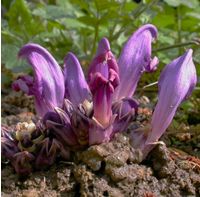
However, Lathraea is also a protocarnivorous plant. Its underground stems have cup shaped leaves with sticky hairs that can trap and digest insects and the abundance of insect life in the boggy soil may have made it less dependent on tree roots.
From the bog garden the stream enters the 'Great Pond', a remnant of the original abbey. It then flows via a series of cascades into the 'Canal Pond', the 'Mermaid Pond' and finally the 'Long Pond'.

As pumped fountains go, it is however still quite small compared to the Jet d'Eau at Geneva (459ft/140m), the Gateway Geyser in St Louis (630ft/260m) and the tallest of all, the King Fahd's Fountain in Jeddah (853ft/260m). These are all single jets so, while impressive, they are possibly outdone for spectacle by the multiple displays of the fountains at the Bellagio Hotel in Las Vegas and the Dubai fountain, where amongst smaller jets there are multiple booming giants shooting 460ft and 500ft respectively. For all their spectacle, there is nothing to beat the gentle trickle of a small stream, fountain or cascade to enhance any garden.
*To conserve water the Emperor fountain is usually nearer 150ft.
Plant of the Month
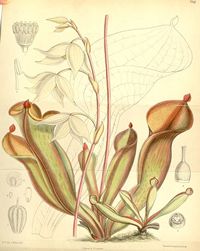
Growing in the marshy highlands of the Guiana Shield, the pitcher plant Heliamphora nutans is intricately adapted to its environment. Produced by a 1.7 billion year old Precambrian sandstone formation in northeast South America, the Guiana Shield underlies Guyana, Suriname, French Guiana and parts of Brazil, Colombia and Venezuela.
In 1978, Ken Burras (Superintendent of the Botanic Garden between 1963 and 1988) joined a Kew Expedition to Mount Roraima, Guyana; where Heliamphora was originally collected by the Schomburgk brothers in 1839. The expedition returned with 400 plant collections, including Heliamphora.
The Oxford Botanic Garden soon developed expertise in growing these challenging plants, but they were highly collectable, being rare in cultivation. Consequently, it was difficult to stop visitors from stealing them.
In 1987, Ken passed some of the plants to the Micropropagation Laboratory of the Oxford Forestry Institute, formerly part of the Department of Plant Sciences. Led by Stephen Woodward, the team developed an efficient propagation process and was soon able to introduce the plant widely into cultivation. More importantly, sufficient specimens were grown to enable the plant's continuous public display at the Garden. Some of the plants growing at the Botanic Garden today are direct descendants of the original Mount Roraima collection.
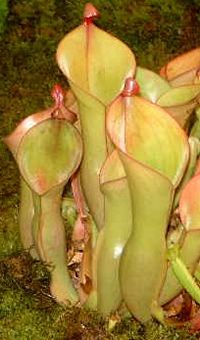
Under this definition, Heliamphora nutans becomes a 'doubtful carnivore' since the presence of digestive enzymes in its pitchers has never been confirmed.
The pitchers are supremely adapted to catching insects. They have a red, sticky nectary zone right at the top containing two types of nectar glands. On the internal surface of the top-half of the pitcher is a zone of downward pointing hairs, surrounding a smooth attractive area. The pitcher constricts and then widens with the lower half covered in hairs, which become denser towards the bottom.
It has recently been shown that when wetted these hairs become extremely slippery and that insects 'aquaplane' into the pitcher, thereby increasing the trapping efficiency. Each pitcher also has an overflow mechanism; a drainage hole at the constriction between the top and bottom halves.
Upper illustration by Joseph Hooker
Lower picture by Steve
Cook
Further reading:
Bauer U et al. 2013. 'Insect aquaplaning' on a superhydrophilic hairy surface:
how Heliamphora nutans Benth. pitcher plants capture prey. Proceedings of the
Royal Society Series B 280 doi: 10.1098/rspb.2012.2569.
Joel DM et al. 1985. Ultraviolet patterns in traps of carnivorous plants. New
Phytologist 101, 585-593. Juniper BJ et al. 1989. Carnivorous plants. Academic
Press.
Alison Foster
Oxford Botanic
Garden
Medicinal Plant of the Month
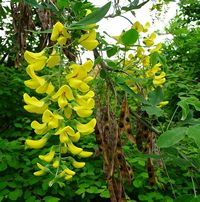
The laburnum tree is found very commonly in gardens in the UK, and is noticeable at this time of year for its long chains of golden yellow flowers. However, the beautiful flowers (picture right by 4028mdk09) hide a dark side to this plant. The seeds (and indeed all parts) of the tree are poisonous to humans and many animals. They are poisonous due to the presence of a very toxic alkaloid called cytisine (not to be confused with cytosine, a component of DNA).
Cytisine has a similar structure to nicotine (another plant natural product), and has similar pharmacological effects. It has been used as a smoking cessation therapy, as has varenicline, which has a structure based on that of cytisine. These molecules are partial agonists at the nicotinic receptor (compared to nicotine which is a full agonist) and reduce the cravings and 'pleasurable' effects associated with nicotine. In 2002 lung cancer was the cause of 1.3 million deaths worldwide. Since the link between smoking and lung cancer was established in 1950, the market for smoking cessation therapies has increased enormously. Today it is worth over $3 billion annually worldwide.
Cytisine is found in several other plants, including the Carolina Lupin, Thermopsis lanceolata, which also looks stunning in early summer.
News from our Associates

The CHA is taking a group of UK companies to the GreenTech Exhibition in Amsterdam
between 10-12 June. Fully-fitted stand options are available on the UK
pavilions and it is hoped to organise a reception during the event. Eligible
companies can receive grants of up to £1,500 towards their costs of
attending and there are still some grants available. Contact CHA for more information.

The Society of Biology and the Heads of University Biosciences (HUBS) held
a joint workshop with the Academy of Medical Sciences and The Physiological
Society. The workshop brought together key stakeholders in higher education
with the aim of informing further work to address the perception that teaching
achievements are not recognised when compared to research achievements in
UK academic careers.
The workshop was held shortly after HEFCE announced the details of its 2014-15 allocations to institutions, where teaching budgets were cut by nearly 6%. There is a risk that a reduction in the funding of teaching at universities could impede work to improve the status of teaching in higher education.
The partner organisations strongly believe that a culture change is needed at universities to address the disparity between teaching and research. To voice this concern, the organisations co-signed a letter to The Guardian which was published on 31. March as a response to an article about the HEFCE teaching allocations. The Society will continue to support higher education teaching. To keep up to date with our work, sign up to our higher education newsletter by registering on our website. More
Horticulture Industry News
For the very latest horticultural news follow us on Facebook,
Twitter, or
LinkedIn
Dormant seeds aid evolution
More than just an insurance policy against late frosts or unexpected dry spells,
it turns out that seed dormancy has long-term advantages too. Plants whose
seeds put off germination until conditions are more certain, give rise to
more species a team of researchers has found. Taking advantage of data compiled
over more than forty years, seed scientists analysed seed dormancy data for
more than 14,000 species of trees, shrubs, vines and herbs from across the
globe.
When they mapped the data onto the seed plant family tree, they found
that plants with the ability to regulate the timing of germination in response
to environmental cues were more likely to spin off new species. Plants whose
seeds have since lost the ability may be more prone to extinction under future
climate change, especially if the timing of sprouting is no longer in tune
with their environment. More
Improving resistance genes
As plant cells, like plants themselves, are fixed in place unable to move,
they lack the mobile defender cells found in animals. Instead, plants have
a highly sophisticated innate immune system based on 'resistance'
genes. These resistance genes are responsible for detecting and responding
to highly specific and dangerous pathogens. Before their discovery, crop breeders
had been unwittingly selecting for these resistance genes for centuries. Researchers
have been working on a particular model resistance gene from potato, called
Rx, which provides resistance to a virus.
In 2006 they showed that the recognition spectrum could be altered, creating broad recognition versions of Rx. The new research follows on from this work and shows that the sensitivity of Rx can also be enhanced, by simply targeting a different portion of the gene. The strategy used for both of these studies was to isolate the gene from the plant, randomly mutate it and screen for variants with improved characteristics before finally re-inserting the modified Rx gene back into the plant - hence artificial evolution.
This is similar to a process called 'somatic hypermutation'
which occurs in animals during infection when antibodies with the best recognition
capabilities are selected by the body to fight the invading pathogen. As all
plants use these same resistance genes this technique could prove particularly
useful as a means to generate resistance to newly emerging pathogens for which
effective resistance genes do not currently exist in the wild. More
How pathogenic E. coli binds to fresh vegetables
Researchers have identified that Escherichia coli uses whip-link
structures on its surface known as flagella - typically used for bacterial
motility - to penetrate the plant cell walls. The team showed that purified
flagella were able to directly interact with lipid molecules found in the
membranes of plant cells while E. coli bacteria lacking flagella
were unable to bind to the plant cells. Once attached, the E. coli are
able to grow on, and colonise, the surface of the plant.
At this point, they
can be removed by washing, although the researchers showed that a small number
of bacteria are able to invade inside the plant, where they become protected
from washing. The group have shown that E. coli is able to colonise
the roots of both spinach and lettuce.
Harper Adams addresses UK's lack of plant scientists
Harper Adams University has shown a commitment to addressing the skills gap
in plant pathology highlighted by a House of Commons Select Committee, by
establishing a new postgraduate degree course in the subject. The course positions
Harper Adams as the UK's only provider of a dedicated masters-level programme
in plant pathology, recognising the need for more plant scientists to prevent
disease outbreaks.
Despite food production tripling in the past 40 years, around 30% of all available food is wasted during production, processing and distribution. Crop losses through plant diseases are an important component of these losses. There is a shortage of expertise in this important topic, which is a key element in the effort to ensure global food security and mitigating the effects of climate change. More
Plants that practice genetic engineering
In the debate over genetically modified crops, one oft-said word is 'unnatural.'
But nature turns out to be its own genetic engineer. Genes have moved from one
species of plant to another for millions of years. Scientists describe a spectacular
case in which ferns acquired a gene for sensing light from a moss-like plant
called hornwort. Gaining the gene appears to have enabled the ferns to thrive
in shady forests.
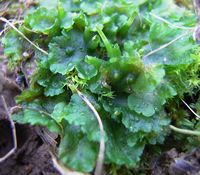
These primitive plants, which lack roots or stems, grow in mats on damp banks
or on trees. It was a strange connection to find because hornworts are only
distantly related to ferns. Comparing all their data the researchers came up
with an unexpected hypothesis. Neochromes did not gradually evolve in ancient
ferns. Instead, a single lineage of ferns picked up the neochrome gene from
hornworts about 180 million years ago by natural 'genetic engineering'. More
Understanding plant disease resistance
Researchers have made a major advance in understanding plant disease resistance.
It was known that proteins called RRS1 and RPS4 are required to recognize
specific molecules from pathogenic bacteria, and then use this recognition
as a cue to activate defence. However the mechanism was unknown. RPS4 and
RRS1 are both required for resistance to Pseudomonas syringae, the
soil-borne Ralstonia solanacearum and the fungal pathogen Colletotrichum
higginsianum.
How this unique dual-protein recognition system operates has remained unknown. Now it has been shown that these proteins intimately associate and they have revealed part of that association at atomic detail. They also found that mutations which perturb this association, disrupt its function, and leave plants more vulnerable to attack.
Birthplace of the domesticated chilli pepper identified
Central-east Mexico has been pin-pointed as the origin of the domesticated
chilli pepper - now the world's most widely grown spice crop. Results from a
four-pronged investigation - based on linguistic and ecological evidence as
well as the more traditional archaeological and genetic data - suggest a regional,
rather than a geographically specific, birthplace for the domesticated chilli
pepper.
That region, extending from southern Puebla and northern Oaxaca to southeastern Veracruz, is further south than was previously thought. The region also is different from areas of origin that have been suggested for common bean and corn, which were presumably domesticated in Western Mexico. More
Wingland Foods expands
Wingland Foods, part of the UK based Bakkavor Group, celebrated the official
opening of its new despatch area and completion of a factory extension. The
new extension has been designed to increase capacity in the factory and the
additional space will be used to support future growth. Wingland Foods, based
in Sutton Bridge, Lincolnshire, is Bakkavor's designated factory for the production
of Waitrose Salads.
British Growers Association names new Chief Executive
Jack Ward has been appointed Chief Executive of the British Growers Association.
He took up his new role on 28 April. Mr Ward was previously Chief
Executive of City & Guilds / NPTC and NFU Regional Director for the East
Midlands. A Nuffield Scholar and former Chairman of the Nuffield Farming Scholarships
Trust, he was awarded the Fellowship of the Royal Agricultural Societies (FRAgS)
in 2014 for services to agriculture.
Based in Louth, Lincolnshire, British Growers represents and promotes the interests of the UK horticulture sector, with a strong focus on driving sales growth and efficiency gains in home-grown vegetable and salad crops.
Scientists grow longer-lasting salad
Researchers have worked with Vitacress, one of the biggest producers of packaged
salads, to understand what keeps salad leaves fresh for longer. Their results
are now being used in breeding programmes and within Vitacress' own practices
to produce salads with a longer shelf life. Before they reach our supermarkets,
baby salad leaves undergo rigorous processing that includes harvesting, transportation,
washing, sanitisation, removal of excess water, and packaging.
Only the most robust leaves can survive this process without being bruised and damaged. The researchers first identified what it was about certain salad leaves that gave them a longer shelf life. They found that smaller, tougher leaves, with lots of small cells packed closely together, lasted longer. They then worked out which regions of the lettuce genome were responsible for these desirable characteristics.
As a result of this research, the scientists have initiated a breeding programme in which crop breeders are selectively breeding plants with the genetic material responsible for leaves with a longer shelf-life. This makes growing salad crops with 'processable' leaves extremely important for the packaged salad industry, as it reduces waste and increases shelf life. More
New British hop launched
A brand new British hop named Olicana, grown by Charles Faram & Co Hop
Merchants and test brewed by Ilkley Brewery, has been unveiled. Olicana seed
was originally sown in 2009 and in 2013, after three years of agronomic assessment,
Charles Faram and Ilkley Brewery teamed up to exclusively harvest and brew
with this new hop. Ilkley Brewery will brew exclusively with Olicana this
season but it is hoped the hop will go into full scale production in 2015.
The name Olicana was chosen in honour of the Yorkshire spa town of Ilkley; Olicana being the name of the Roman fort from which the town grew. The Olicana hop is a daughter of the US variety, Cascade, and an English male from the Charles Faram hop development programme. It boasts mango, grapefruit and passionfruit qualities. The new breeding programme has been established to compliment the great work that Peter Darby is doing at Wye Hops Ltd, giving a two-pronged attack to the search for more highly aromatic British hops. More
A new approach to detecting changes in GM foods
Does genetic manipulation cause unintended changes in food quality and composition?
Scientists extracted roughly 1,000 biochemicals from the fruit of tomatoes.
These tomatoes had been genetically engineered to delay fruit ripening - a common
technique to help keep fruits fresher longer. The researchers then compared
this 'metabolic profile' from the GM fruit to the profile of its non-GM variety.
Extracting and analyzing hundreds metabolites at once gives researchers a snapshot of the fruit's physiology, which can be compared against others. When they compared the biochemicals of the GM tomato and a wide assortment other non-GM tomatoes, including modern and heirloom varieties, they found no significant differences overall.
Thus, although the GM tomato was distinct from its parent, its metabolic profile still fell within the 'normal' range of biochemical diversity exhibited by the larger group of varieties. However, the biochemicals related to fruit ripening did show a significant difference - no surprise because that was the intent of their breeding.
Sugar responsible for shooting
A study has overturned the long-held belief that plant hormones control the
shape of plant growth, and shown instead that this process starts with sugar.
The scientists showed that shoot branching can begin up to 24 hours before
auxin levels change, so it cannot be responsible for initiating this process.
Instead it was found that shoot growth occurs when a high concentration of sugar - produced by the plant through photosynthesis - is available. Plants have a 'goliath' main shoot which hoards the sugars to promote its growth. If the main shoot is damaged or removed the sugars are quickly redistributed to start the growth of new shoots. More
Why food quality will suffer with rising carbon dioxide
For the first time, a field test has demonstrated that elevated levels of
carbon dioxide inhibit plants' assimilation of nitrate into proteins, indicating
that the nutritional quality of food crops is at risk as climate change intensifies.
Food quality is declining under the rising levels of atmospheric carbon dioxide
that we are experiencing.
Several explanations for this decline have been put forward, but this is the first study to demonstrate that elevated carbon dioxide inhibits the conversion of nitrate into protein in a field-grown crop. The assimilation of nitrogen plays a key role in the plant's growth and productivity. In food crops, it is especially important because plants use nitrogen to produce the proteins that are vital for human nutrition. More
Events Calendar
Plant
Genomics Conference
12 - 13 May, Global Engage
London, UK
Brassica Conference
15 May, UK Brassica Research Community
Wellesbourne, UK
Loquat Symposium
12 - 15 May, International Society for Horticultural Science
Palermo, Italy
Society
of Biology AGM
15 May
London, UK
Plant
Chemical Biology
16 May, Agrinet
Jealotts Hill, UK
Risk
assessment considerations for RNAi-based GM plants
4 Jun, European Food Safety Authority
Brussels, Belgium
IFTEX
4 - 6 Jun, HPP Exhibitions
Nairobi, Kenya
London Produce
Show
4 - 6 Jun, Fresh Produce Consortium & Produce Business
London, UK
CO2
Assimilation in Plants: Genome to Biome
7 - 8 Jun, Gordon Research Conferences
Waterlooville Valley, USA
World Processing
Tomato Congress
8 - 11 Jun, International Society for Horticultural Science
Sirmione, Italy
GreenTech
10 - 12 Jun, Amsterdam RAI
Amsterdam, The Netherlands
Biocontrol
of Plant Diseases: 'From the field to the laboratory and back again'
15 - 18 Jun, Swedish University of Agricultural Sciences
Uppsala, Sweden
Urban
Tree Diversity
16 - 18 Jun, Arboriculture Association
Alnarp, Sweden
Postharvest Unlimited
19 - 13 Jun, International Society for Horticultural Science
Cyprus
Breeding
Plants to Cope with Future Climate Change
16 - 18 Jun, Association of Applied Biologists
Leeds, UK
Agronomic
Decision Making in an Uncertain Climate
19 Jun, Association of Applied Biologists
Leeds, UK
Plant Biology Europe
22 - 26 Jun, EPSO
Dublin, Ireland
Oxygen-binding
and sensing proteins
6 - 10 Jul, Society of Experimental Biology
Sheffield, UK
International
Food Legumes Research Conference
7 Jul - 11 Jul, University of Saskatchewan
Saskatoon, Canada
Chemical and Non-Chemical
Soil and Substrate Disinfestation
13 - 18 Jul, International Society for Horticultural Science
Turin, Italy
Pear
Symposium
14 - 18 Jul, International Society for Horticultural Science
Leuven, Belgium
Systems
biology and ecology of CAM plants
15 - 18 Jul 2104, New Phytologist Trust
Tahoe City, USA
Fruit
for the Future
17 Jul, James Hutton Institute
Dundee, UK
Fruit Focus
23 Jul, Haymarket Exhibitions
East Malling, UK
Grapevine
Breeding and Genetics
28 Jul - 8 Aug, International Society for Horticultural Science
Beijing, China
If you would like to advertise a forthcoming event please contact. ester.monfort@soci.org
Horticulture Group Contact Details
For submitting ideas or to volunteer to be part of a committee or a group, please contact:
Chairman - Peter Grimbly
Meetings Secretary - Alison Foster
Minutes Secretary - Margaret Waddy
Newsletter co-ordinator - Sue Grimbly scihortigroup@btinternet.com
Group Contact - Ester Monfort Martinez, E: ester.monfort@soci.org T: +44(0)20 7598 1584

